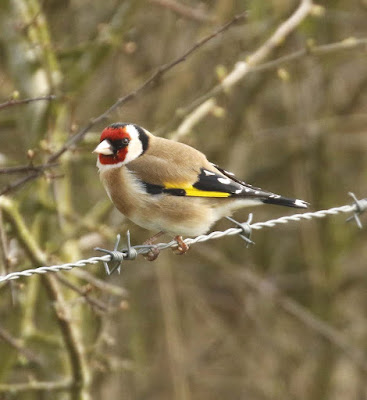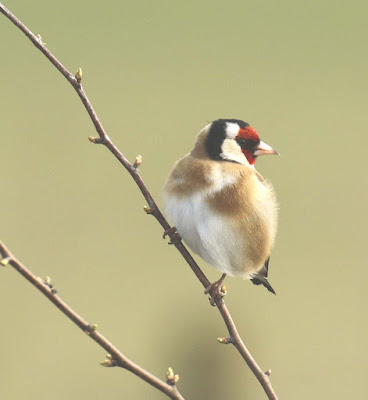On the RSPB's large reserve at Otmoor in Oxfordshire there is only one Hide, The Wetlands Hide which lies just fifty metres along a wide footpath come track leading off from the main bridleway that crosses the reserve.
 |
| The footpath seen from The Wetlands Hide |
The footpath is relatively undisturbed and the RSPB and its volunteer wardens have spread seed along the footpath by the Hide to attract finches and buntings which has been very successful and consequently this allows visitors to the Hide to get close up views of, at peak times in winter, a flock of several hundred buntings and finches that come to the seed. Naturally the seed also attracts other species and this afternoon a male Pheasant and some Stock Doves were also taking advantage.
Today was a day of mixed weather, with periods of cloud and then sunshine accompanied by a strong, blustery and cold northeast wind and after a rather strenuous and over ambitious session in the gym this morning, it seemed a good day to sit in the Hide and observe the comings and goings of the finch and bunting flock, now somewhat diminished in numbers from its peak in mid winter
By far the most plentiful species making up the flock were the Reed Buntings, there must have been in excess of fifty, the majority were males with just a few females present. Why this should be so I have no idea but have noticed this phenomenon before and sometimes the roles have been reversed and there are more females than males.
 |
| Female Reed Bunting |
The feeding flock regularly took alarm and would fly off, sometimes for good reason, as a female Sparrowhawk had taken to flying fast and low along the track hunting for any unwary bird to seize but as far as I could see on the three passes she made while I was around she was unsuccessful. The Reed Buntings were always the first to return, landing in the small hedgerow hawthorns or on the barbed wire fence along the edge of the track and would sit nervously with tails flicking open to reveal their white edges until one of their number would take courage and descend to the ground to feed, whereupon the rest would follow. Many of the males were now in almost full breeding plumage but on closer inspection it could be seen they were still showing a bit of brown or grizzled white winter feathering in the black of their heads and chins, some more so than others.
 |
| Male Reed Buntings |
With the return of the Reed Buntings the other species would eventually follow. In order of appearance it was usually the Chaffinches, then the Goldfinches, a flock of Linnets which kept very much to themselves and did everything together and finally the Yellowhammers, last but by no means least and the main reason for my going to the Hide in the first place.
 |
| Male Chaffinch |
It was instructive to note the difference in bill shape of the Yellowhammers compared to the finches, in that the Yellowhammers display an upper mandible that is rather flat on the top giving a distinctive slightly asymmetrical shape to the bill. I have also noticed this in Snow and Lapland Buntings too. The finches by contrast have a convex shape to their upper mandible giving the bill a conical, satisfying and symmetrical look.
The Goldfinches were an absolute delight, landing as a small flock of around ten or more birds on the thinnest topmost twigs of the small, budding hawthorns, twittering and tinkling their rapid conversational notes to each other. Their demure size only serves to accentuate their innate attractiveness. When seen so close the mixture of lovely colours in their plumage makes me wonder why I so take them for granted. Their face is a combination of red, white and black and their wings flash golden yellow with prominent white spots at the tips of the black wing and tail feathers.
 |
| Goldfinches |
The Linnets were by far the most nervy and least inclined to settle of all the birds feeding here. Maybe it is because they are so used to being in a tight flock and it only takes one bird to be alarmed for the rest to immediately respond and disappear as a flock into the wide windswept sky, their hard contact notes urging each other on. Towards the end of my two hour vigil in the Hide only a few Linnets were coming back to the seed and then they seemed less nervous than when in a flock, although still very wary. A male perched on a hawthorn twig, unsure of whether to descend to the ground and sat for a minute or two. He was well into acquiring his breeding plumage with a breast heavily suffused with rose pink but his grey forehead had yet to acquire a similar colouring, being still obscured by the grey brown fringes of the feathering which will now rapidly wear away to reveal the pink. Here is another bird whose subtle beauty is only apparent when seen close up. Although lacking the pink patches the white in the wing and tail feathers brings variety to the brown upperparts, streaked buff underparts and grey head of the more dowdy female.


 |
| Male Linnet |
 |
| Female Linnet |
The Yellowhammers were in the minority and as befits the brief interludes when they were present, very much the stars. I could only see two males and two females, so possibly they were two pairs. After a general alarm resulting in the flock of finches and buntings dispersing they were always the last to return and would perch for a considerable time in the bushes, the most wary of all the birds, looking unsure, and often would fly off again without feeding. On one occasion only, a male did descend to the ground and feed with the other birds and this was my opportunity to get some images.
The males are in my opinion one of the more unappreciated when it comes to beauty of plumage. The bright yellow of their head and upper breast positively glows in the sunlight and often when you see them sat at the top of a bush in spring and summer it is their bright yellow head, almost disembodied, that gives them away in the fresh green leaves which hide the rest of their body. Their upper body is brown streaked darker but their rump is much brighter, being a rich, orange brown. Quite beautiful.
 |
| Male Yellowhammer |
As a species they are, like so many of our birds associated with agriculture, having a hard time of it and their numbers are declining alarmingly. This may be why they are so few in number at Otmoor and today, although I realised there was little I could do about this, at least I could enjoy the beauty of the two males that graced this little corner of Otmoor. So thank you RSPB, once again.































No comments:
Post a Comment